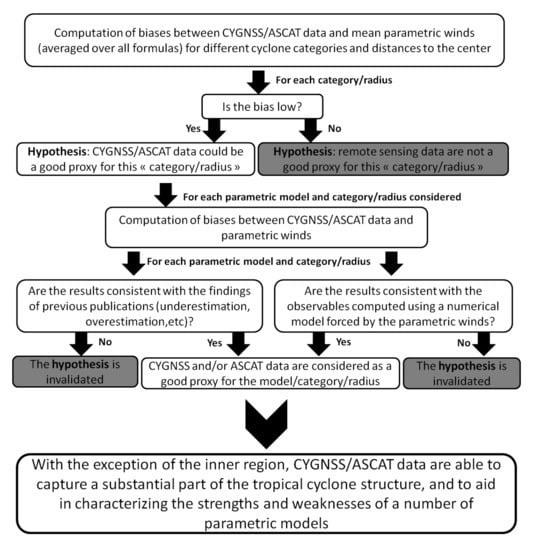Can We Improve Parametric Cyclonic Wind Fields Using Recent Satellite Remote Sensing Data?
Abstract
1. Introduction
- Validations of parametric wind models are generally performed using a limited number of “ground-truth” data. In-situ observations of surface wind speeds are relatively sparse for TCs, as they spend most of their lifetime over the oceans, where the density of buoys able to record extreme winds is relatively small. Besides, the wind recorded by meteorological stations can be biased because of terrestrial effects, which makes it difficult to compare observations with parametric values in a consistent way. Although these issues are offset to some extent in the North Atlantic and East Pacific thanks to aircraft reconnaissance, it remains a major problem in all oceanic basins;
- new proposed parametric models are generally compared with a limited number of existing gradient wind profiles. Except the work of Lin and Chavas [17], we are not aware of any study investigating parametric wind models over a wide range of parameters and methods. New proposed models are often compared to the Holland [33] or Jelesnianski and Taylor [35] approaches to assess their quality, and disregard more recent models, such as Willoughby et al. [38] or Emanuel and Rotunno [36]. It is thus difficult to assert that these new models really perform better than all existing approaches;
- new proposed parametric models are generally tested without considering all the available information on TC wind structure. As noted above, very few studies take into account all the available information about wind structure, such as the 34-kt, 50-kt, and 64-kt wind radii for each quadrant. Most of the time, only the radius of maximum winds or the hurricane-force (i.e., 64-kt) wind radii are used, which can potentially result in errors far from the cyclone center. It is thus unclear whether the discrepancies between the model and the observed data are due to the model itself, or to the fact that the model is not sufficiently constrained by available information (such as the 34-kt, 50-kt, and 64-kt wind radii); and
- some of the parameters used in parametric wind models are not always clearly specified. For example, the surface wind reduction factor (SWRF [39]), i.e., the empirical ratio between the surface and the top of the boundary layer, is rarely indicated, although it generally plays a significant role in the estimated parametric wind speeds [17].
2. Data and Methods
2.1. CyclonesSelection
2.2. Remote Sensing Data
- The “wind speed” (ws) product is derived from the best fit to both the normalized bistatic radar cross-section (NBRCS) and leading edge slope (LES) of the integrated delay waveform given by the delay-Doppler maps (DDM [42]), using the geophysical model function (GMF) appropriate for fully developed seas;
- the “yslf_les_wind_speed” (les) wind product is derived from only the LES of the DDM, using a young seas/limited-fetch GMF; and
- the “yslf_nbrcs_wind_speed” (nbrc) product is derived from only the NBRCS, using the young seas/limited-fetch GMF.
2.3. Parametric Wind Models
- From the NHC advisories, the surface background wind relative to the cyclone translation velocity is estimated at the time of acquisition of the CYGNSS/ASCAT data point under consideration. Following the approach of Lin and Chavas [17], we assume that this wind is decelerated by a factor of α = 0.56 and rotated counter-clockwise by an angle of β = 19.2° from the free tropospheric wind.
- The translational portion of the wind speed is removed from the maximum observed wind velocity and the 34-, 50-, and 64-kt winds.
- Surface velocities given by the NHC are converted to velocities at the top of the atmospheric boundary layer by applying an empirical surface wind reduction factor, SWRF [39]. In the following sections, we use SWRF = 0.9. Other values were tested, but they did not change the conclusions of this paper. For the sake of brevity, these results are not presented here.
- The radii of maximum winds are estimated for the four quadrants, using the chosen parametric gradient wind profile, and the available wind radii information. For each quadrant, up to three radii of maximum winds are thus obtained: One estimated using the 64-kt wind radius (Rm64), another one from the 50-kt wind radius (Rm50), and a third from the 34-kt wind radius (Rm34).
- Depending on the case, Rm64, Rm34, or all the radii of maximum winds (Rm64, Rm50, and Rm34) are computed for the data point azimuth, using a spline interpolation.
- The parametric wind speed value at the CYGNSS/ASCAT data point is computed using the chosen parametric gradient wind profile. This step is straightforward if a single radius of maximum winds is considered. In the case where all the radii of maximum winds (Rm64, Rm50, and Rm34) are considered, the parametric wind speed is computed using a linear weighting approach similar to the one proposed by Hu et al. [45]. For example, for a CYGNSS/ASCAT point located at a distance, r, from the cyclone center larger than the 64-kt wind radius (r64), but lower than the 50-kt wind radius (r50), we:
- (a) Compute VRm64, the parametric wind speed at the CYGNSS/ASCAT data point location obtained using Rm64;
- (b) compute VRm50, the parametric wind speed at the CYGNSS/ASCAT data point location obtained using Rm50; and
- (c) compute the final parametric wind speed, V, using the following equation:
This approach ensures that all the wind radii information are satisfied. - The velocity, V, is multiplied by SWRF to obtain the parametric wind speed at the surface.
- The wind speed obtained in the previous step is combined with the surface background wind computed in step 1 to get the final parametric wind speed at the CYGNSS/ASCAT data point considered.
2.4. Methodology
- First, the biases between CYGNSS/ASCAT data and wind speeds inferred from the ensemble mean parametric winds (i.e., averaged over all formulas) are computed for different cyclone categories and distances to the center, to identify the cases for which CYGNSS and/or ASCAT could be good proxies for wind speeds. Due to the relatively large number of independent parametric formulations we consider (seven), individual errors are indeed expected to be trimmed down in such an ensemble mean.
- Second, based on assumptions about CYGNSS/ASCAT data, the biases of individual parametric models are computed to check whether our hypotheses enable reproduction of the findings of previous studies in terms of performance for wind gradient profiles.
- Third, we investigate whether our assumptions about CYGNSS/ASCAT data allow for identification of relevant parametric models for a specific case study: The category 5 hurricane Maria.
3. Comparison of CYGNSS and ASCAT Data
- ASCAT performs well for r > R34;
- ASCAT also performs well for R34 < r < R50 and category 3/5 cyclones (this product shows the lowest biases in these cases);
- none of the space-borne products tested here are reliable for smaller radii than R64 in the case of category 1 cyclones. We will not investigate these conditions in the next sections; and
4. Performance of Parametric Wind Models
- The inner region solution of Emanuel and Rotunno [36], E11, gives relatively small biases (hence, good results) close to the storm center, especially for intense and well defined cyclones. It is also found to underestimate wind speeds far from the center when constrained only by R64, as found in Lin and Chavas [17]. E04 performs better for the outer region, but poorly near the center. E11 and E04 can thus be merged to develop a complete TC radial wind structure as proposed by Chavas et al. [49];
- when solely constrained by radii close to the cyclone center (here R64), the Holland profile (H80) underestimates the winds in the outer region, as noted by Willoughby and Rahn [34]. This can also lead to broad wind maxima, and thus wind overestimations several dozens of kilometers from the center for strong cyclones, as can be seen also in Figure 3.
- J92 gives significantly higher wind speeds far from the center compared to most of the other parametric formulas, when constrained by R64 only. This is consistent with the findings of Lin and Chavas [17]. Our results suggest, however, that these wind speeds are generally not overestimated, and might better represent the wind decay as a function of the radius compared to other formulas;
- the results are generally much better when considering a family of profiles with two characteristic lengths, as proposed by Willoughby et al. [38]. For example, as stated above, the performance of the Holland model, H80, is significantly improved when both radii at 34-kt and 64-kt are prescribed; and
5. Comparison with In-Situ Oceanic Data
- Astronomic tidal potential over the whole domain (12 constituents);
- 26 tidal harmonic constituents at the open boundaries, provided by the global FES2012 model [51];
- parametric pressure fields [33]; and
- parametric winds blended with CFSR (Climate Forecast System Reanalysis [52]) wind data. The parametric winds are prescribed for smaller radii than R34, whereas CFSR data are imposed for r > 1.5 R34. In between, a smooth transition is ensured using a weighing coefficient, which varies linearly with radius r.
- E11 and H80, constrained using the 64-kt wind radii only (E11(R64) and H80(R64) in Figure 6);
- E11 and H80, constrained using all the wind radii information (E11(All) and H80(All) in Figure 6);
- E11H80, for which we choose to blend the wind speeds inferred from E11 for the inner core region with those given by H80 for the outer region (see the black contours in Figure 3); and
- M16b, a blend between wind speeds obtained from M16 constrained by R64 only and with all wind radii information (see black contours in Figure 4).
- H80 and E11 constrained only by the 64-kt wind radius (R64) give the worst results, with Hs generally significantly underestimated, and NRMS ranging between 20% and 50% (Table 3). This is consistent with the results of Figure 3 and Figure 4, which show large negative biases for H80 and E11 in the case of category 4–5 cyclones and wider radii than R64;
- constraining all the 34-kt, 50-kt, and 64-kt wind radii (All) results in better performance for E11, with reduced bias and NRMS (15% to 22% approximately), although significant wave heights are now overestimated. This is again consistent with the findings of Figure 3, which shows a positive bias at all radii for category 4 and 5 events;
- H80 constrained by all wind-radii information strongly overestimates Hs when Maria is closest to the storm. This is also consistent with the results of Figure 3 (and the findings of Willoughby and Rahn [34]), which show that H80 tends to overestimate wind speeds close to the center of strong (category 4–5) cyclones. The prediction is better when Maria moves further away, which is also expected and
- the best results are obtained for E11H80 and M16b, the two parametric models built to minimize the biases. NRMS values of the order of 9%–20% are obtained for significant wave heights, which is a good score considering the cyclone asymmetry due to the complexity of the area, characterized by a number of mountainous islands separated by just a few dozen kilometers.
6. Conclusions
Author Contributions
Funding
Acknowledgments
Conflicts of Interest
References
- Vickery, P.J.; Masters, F.J.; Powell, M.D.; Wadhera, D. Hurricane hazard modeling: The past, present, and future. J. Wind Eng. Ind. Aerodyn. 2009, 97, 392–405. [Google Scholar] [CrossRef]
- Lin, N.; Smith, J.A.; Villarini, G.; Marchok, T.P.; Baeck, M.L. Modeling extreme rainfall, winds, and surge from Hurricane Isabel (2003). Weather Forecast. 2010, 25, 1342–1361. [Google Scholar] [CrossRef]
- Hsiao, L.F.; Chen, D.S.; Kuo, Y.H.; Guo, Y.R.; Yeh, T.C.; Hong, J.S.; Fong, C.T.; Lee, C.S. Application of WRF 3DVAR to operational typhoon prediction in Taiwan: Impact of outer loop and partial cycling approaches. Weather Forecast. 2012, 27, 1249–1263. [Google Scholar] [CrossRef]
- Powers, J.; Klemp, J.; Skamarock, W.; Davis, C.; Dudhia, J.; Gill, D.; Coen, J.; Gochis, D.; Ahmadov, R.; Peckham, S.; et al. The weather research and forecasting (WRF) model: Overview, system efforts, and future directions. Bull. Am. Meteorol. Soc. 2017. [Google Scholar] [CrossRef]
- Lakshmi, D.; Murty, P.L.N.; Bhaskaran, P.K.; Sahoo, B.; Srinivasa Kumar, T.; Shenoi, S.S.C.; Srikanth, A.S. Performance of WRF-ARW winds on computed storm surge using hydrodynamic model for Phailin and Hudhud cyclones. Ocean Eng. 2017, 131, 135–148. [Google Scholar] [CrossRef]
- Mattocks, C.; Forbes, C. A real-time, event-triggered storm surge forecasting system for the state of North Carolina. Ocean Model. 2008, 25, 95–119. [Google Scholar] [CrossRef]
- Lin, N.; Emanuel, K.A. Grey swan tropical cyclones. Nat. Clim. Chang. 2016, 6, 106–111. [Google Scholar] [CrossRef]
- Orton, P.M.; Hall, T.M.; Talke, S.A.; Blumberg, A.F.; Georgas, N.; Vinogradov, S. A validated tropical-extratropical flood hazard assessment for New York harbor. J. Geophys. Res. Oceans 2016, 121, 8904–8929. [Google Scholar] [CrossRef]
- Krien, Y.; Testut, L.; Durand, F.; Mayet, C.; Islam, A.K.M.S.; Tazkia, A.R.; Becker, M.; Calmant, S.; Papa, F.; Ballu, V.; et al. Towards improved storm surge models in the northern Bay of Bengal. Cont. Shelf Res. 2017, 135, 58–73. [Google Scholar] [CrossRef]
- Shao, Z.; Liang, B.; Li, H.; Wu, G.; Wu, Z. Blended wind fields for wave modeling of tropical cyclones in the South China Sea and East China Sea. Appl. Ocean Res. 2018, 71, 20–33. [Google Scholar] [CrossRef]
- Feng, X.; Li, M.; Yin, B.; Yang, D.; Yang, H. Study of storm surge trends in typhoon-prone coastal areas based on observations and surge-wave coupled simulations. Int. J. Appl. Earth Obs. Geoinf. 2018. [Google Scholar] [CrossRef]
- Tan, C.; Fang, W. Mapping the Wind Hazard of Global Tropical Cyclones with Parametric Wind Field Models by Considering the Effect of Local Factors. Int. J. Disaster Risk Sci. 2018. [Google Scholar] [CrossRef]
- Niedoroda, A.W.; Resio, D.T.; Toro, G.R.; Divoky, D.; Das, H.S.; Reed, C.W. Analysis of the coastal Mississippi storm surge hazard. Ocean Eng. 2010, 37, 82–90. [Google Scholar] [CrossRef]
- Haigh, I.D.; MacPherson, L.R.; Mason, M.S.; Wijeratne, E.M.S.; Pattiaratchi, C.B.; Crompton, R.P.; George, S. Estimating present day extreme water level exceedance probabilities around the coastline of Australia: Tropical cyclone-induced storm surges. Clim. Dyn. 2014, 42, 139–157. [Google Scholar] [CrossRef]
- Krien, Y.; Dudon, B.; Roger, J.; Zahibo, N. Probabilistic hurricane-induced storm surge hazard assessment in Guadeloupe, Lesser Antilles. Nat. Hazards Earth Syst. Sci. 2015, 15, 1711–1720. [Google Scholar] [CrossRef]
- Krien, Y.; Dudon, B.; Roger, J.; Arnaud, G.; Zahibo, N. Assessing storm surge hazard and impact of sea level rise in Lesser Antilles-Case study of Martinique. Nat. Hazards Earth Syst. Sci. 2017, 17, 1559–1571. [Google Scholar] [CrossRef]
- Lin, N.; Chavas, D. On hurricane parametric wind and applications in storm surge modeling. J. Geophys. Res. 2012, 117, D09120. [Google Scholar] [CrossRef]
- Olfateh, M.; Callaghan, D.P.; Nielsen, P.; Baldock, T.E. Tropical cyclone wind field asymmetry—Development and evaluation of a new parametric model. J. Geophys. Res. Oceans 2017, 122, 458–469. [Google Scholar] [CrossRef]
- Knaff, J.A.; Longmore, S.P.; DeMaria, R.T.; Molenar, D.A. Improved Tropical-Cyclone Flight-Level Wind Estimates Using Routine Infrared Satellite Reconnaissance. J. Appl. Meteorol. Clim. 2015, 54, 463–478. [Google Scholar] [CrossRef]
- Dolling, K.; Ritchie, E.; Tyo, J. The Use of the Deviation Angle Variance Technique on Geostationary Satellite Imagery to Estimate Tropical Cyclone Size Parameters. Weather Forecast. 2016, 31, 1625–1642. [Google Scholar] [CrossRef]
- Mueller, K.J.; DeMaria, M.; Knaff, J.A.; Kossin, J.P.; VonderHaar, T.H. Objective estimation of tropical cyclone wind structure from infrared satellite data. Weather Forecast. 2006, 21, 990–1005. [Google Scholar] [CrossRef]
- Figa-Saldana, J.; Wilson, J.J.W.; Attema, E.; Gelsthorpe, R.; Drinkwater, M.R.; Stoffelen, A. The advanced scatterometer (ASCAT) on the meteorological operational (MetOp) platform: A follow on for European wind scatterometers. Can. J. Remote Sens. 2002, 28, 404–412. [Google Scholar] [CrossRef]
- Madsen, N.M.; Long, D.G. Calibration and Validation of the RapidScat Scatterometer Using Tropical Rainforests. IEEE Trans. Geosci. Remote Sens. 2016, 54, 2846–2854. [Google Scholar] [CrossRef]
- Meissner, T.; Wentz, F.J. Wind vector retrievals under rain with passive satellite microwave radiometers. IEEE Trans. Geosci. Remote Sens. 2009, 47, 3065–3083. [Google Scholar] [CrossRef]
- El-Nimri, S.F.; Lindwood Jones, W.; Uhlhorn, E.; Ruf, C.; Johnson, J.; Black, P. An improved C-band ocean surface emissivity model at hurricane-force wind speeds over a wide range of Earth incidence angles. IEEE Geosci. Remote Sens. Lett. 2010, 7, 641–645. [Google Scholar] [CrossRef]
- Reul, N.; Tenerelli, J.; Chapron, B.; Vandemark, D.; Quilfen, Y.; Kerr, Y. SMOS satellite L-band radiometer: A new capability for ocean surface remote sensing in hurricanes. J. Geophys. Res. 2012, 117, C02006. [Google Scholar] [CrossRef]
- Reul, N.; Chapron, B.; Zabolotskikh, E.; Donion, C.; Mouche, A.A.; Tenerelli, J.; Collard, F.; Piolle, J.F.; Fore, A.; Yueh, S.; et al. A new generation of tropical cyclone size measurements from space. Bull. Am. Meteorol. Soc. 2017, 98, 2367–2385. [Google Scholar] [CrossRef]
- Zabolotskikh, E.; Mitnik, L.M.; Reul, N.; Chapron, B. New Possibilities for Geophysical Parameter Retrievals Opened by GCOM-W1 AMSR2. IEEE J. Sel. Top. Appl. Earth Obs. Remote Sens. 2015, PP, 1–14. [Google Scholar] [CrossRef]
- Fore, A.G.; Yueh, S.H.; Tang, W.; Stiles, B.; Hayashi, A.K. Combined Active/Passive Retrievals of Ocean Vector Wind and Sea Surface Salinity with SMAP. IEEE Trans. Geosci. Remote Sens. 2016, 54, 7396–7404. [Google Scholar] [CrossRef]
- Foti, G.; Gommenginger, C.; Jales, P.; Unwin, M.; Shaw, A.; Robertson, C.; Rosell, J. Spaceborne GNSS reflectometry for ocean winds: First results from the UK TechDemoSat-1 mission. Geophys. Res. Lett. 2015, 42, 5435–5441. [Google Scholar] [CrossRef]
- Ruf, C.S.; Atlas, R.; Chang, P.S.; Clarizia, M.P.; Garrison, J.L.; Gleason, S.; Katzberg, S.J.; Jelenak, Z.; Johnson, J.T.; Majumdar, S.J.; et al. New Ocean Winds Satellite Mission to Probe Hurricanes and Tropical Convection. Bull. Am. Meteorol. Soc. 2016, 97, 385–395. [Google Scholar] [CrossRef]
- Morris, M.; Ruf, C. Determining Tropical Cyclone Surface Wind Speed Structure and Intensity with the CYGNSS Satellite Constellation. J. Appl. Meteorol. Clim. 2017. [Google Scholar] [CrossRef]
- Holland, G. An Analytic Model of the Wind and Pressure Profiles in Hurricanes. Mon. Weather Rev. 1980, 108, 1212–1218. [Google Scholar] [CrossRef]
- Willoughby, H.E.; Rahn, M.E. Parametric representation of the primary hurricane vortex. Part I: Observations and evaluation of the Holland (1980) model. Mon. Weather Rev. 2004, 132, 3033–3048. [Google Scholar] [CrossRef]
- Jelesnianski, C.P.; Taylor, A.D. A Preliminary View of Storm Surges before and after Storm Modifications; NOAA Technical Memorandum, ERL WMPO-3; Environmental Research Laboratories, Weather Modification Program Office: Boulder, CO, USA, 1973; p. 33. [Google Scholar]
- Emanuel, K.; Rotunno, R. Self-stratification of tropical cyclone outflow, Part I: Implications for storm structure. J. Atmos. Sci. 2011, 68, 2236–2249. [Google Scholar] [CrossRef]
- Murty, P.L.N.; Bhaskaran, P.K.; Gayathri, R.; Sahoo, B.; Srinivasa Kumar, T.; SubbaReddy, B. Numerical study of coastal hydrodynamics using a coupled model for Hudhud cyclone in the Bay of Bengal. Estuar.Coast. Shelf Sci. 2016, 183, 13–27. [Google Scholar] [CrossRef]
- Willoughby, H.E.; Rahn, M.E.; Darling, R.W.R. Parametric representation of the primary hurricane vortex. Part II: A new family of sectionally continuous profiles. Mon. Weather Rev. 2006, 134, 1102–1120. [Google Scholar] [CrossRef]
- Powell, M.D.; Vickery, P.J.; Reinhold, T.A. Reduced drag coefficient for high wind speeds in tropical cyclones. Nature 2003, 422, 279–283. [Google Scholar] [CrossRef] [PubMed]
- Uhlhorn, E.W.; Black, P.G.; Franklin, J.L.; Goodberlet, M.A.; Carswell, J.R.; Goldstein, A.S. Hurricane surface wind measurements from an operational stepped frequency microwave radiometer. Mon. Weather. Rev. 2007, 135, 3070–3085. [Google Scholar] [CrossRef]
- Ruf, C.S.; Gleason, S.; McKague, D.S. Assessment of CYGNSS Wind Speed Retrieval Uncertainty. IEEE J. Sel. Top. Appl. Earth Obs. Remote Sens. 2018, PP, 1–11. [Google Scholar] [CrossRef]
- Saïd, F.; Katzberg, S.J.; Soisuvarn, S. Retrieving Hurricane Maximum Winds Using Simulated CYGNSS Power-Versus-Delay Waveforms. IEEE J. Sel. Top. Appl. Earth Obs. Remote Sens. 2017, 10, 3799–3809. [Google Scholar] [CrossRef]
- ASCAT Wind Product User Manual, KNMI, De Bit, The Netherlands. 2013. Available online: http://projects.knmi.nl/ scatterometer/publications/pdf/ASCAT_Product_Manual.pdf. (accessed on 1 October 2018).
- Verhoef, A.; Portabella, M.; Stoffelen, A. High-resolution ASCAT scatterometer winds near the coast. IEEE Trans. Geosci. Remote Sens. 2012, 50, 2481–2487. [Google Scholar] [CrossRef]
- Hu, K.; Chen, Q.; Kimball, S.K. Consistency in hurricane surface wind forecasting: An improved parametric model. Nat. Hazards 2012, 61, 1029–1050. [Google Scholar] [CrossRef]
- Emanuel, K. Tropical cyclone energetics and structure. In Atmospheric Turbulence and Mesoscale Meteorology; Fedorovich, E., Rotunno, R., Stevens, B., Eds.; Cambridge University Press: Cambridge, UK, 2004; pp. 165–192. [Google Scholar]
- Jelesnianski, C.P.; Chen, J.; Shaffer, W.A. SLOSH: Sea, Lake, and Overland Surges from Hurricanes; NOAA Technical Report NWS 48; NOAA AOML Library: Miami, FL, USA, 1992. [Google Scholar]
- Brennan, M.J.; Hennon, C.C.; Knabb, R.D. The Operational Use of QuikSCAT Ocean Surface Vector Winds at the National Hurricane Center. Weather Forecast. 2009, 24, 621–645. [Google Scholar] [CrossRef]
- Chavas, D.R.; Lin, N.; Emanuel, K. A model for the complete radial structure of the tropical cyclone wind field. Part I: Comparison with observed structure. J. Atmos. Sci. 2015, 72, 3647–3662. [Google Scholar] [CrossRef]
- Zhang, Y.; Ye, F.; Stanev, E.V.; Grashorn, S. Seamless cross-scale modeling with SCHISM. Ocean Model. 2016, 102, 64–81. [Google Scholar] [CrossRef]
- Carrère, L.; Lyard, F.; Cancet, M.; Guillot, A.; Roblou, L. FES2012: A new global tidal model taking advantage of nearly 20 years of altimetry. Paper presented at Proceedings of The Symposium 20 Years of Progress in Radar Altimetry, Venice-Lido, Italy, 24–29 September 2012. [Google Scholar]
- Saha, S.; Moorthi, S.; Wu, X.; Wang, J.; Nadiga, S.; Tripp, P.; Behringer, D.; Hou, Y.T.; Chuang, U.Y.; Iredell, M.; et al. NCEP Climate Forecast System Version 2(CFSv2) Monthly Products; Research Data Archive at the National Center for Atmospheric Research; Computational and Information Systems Laboratory: Boulder, CO, USA, 2012. [Google Scholar]
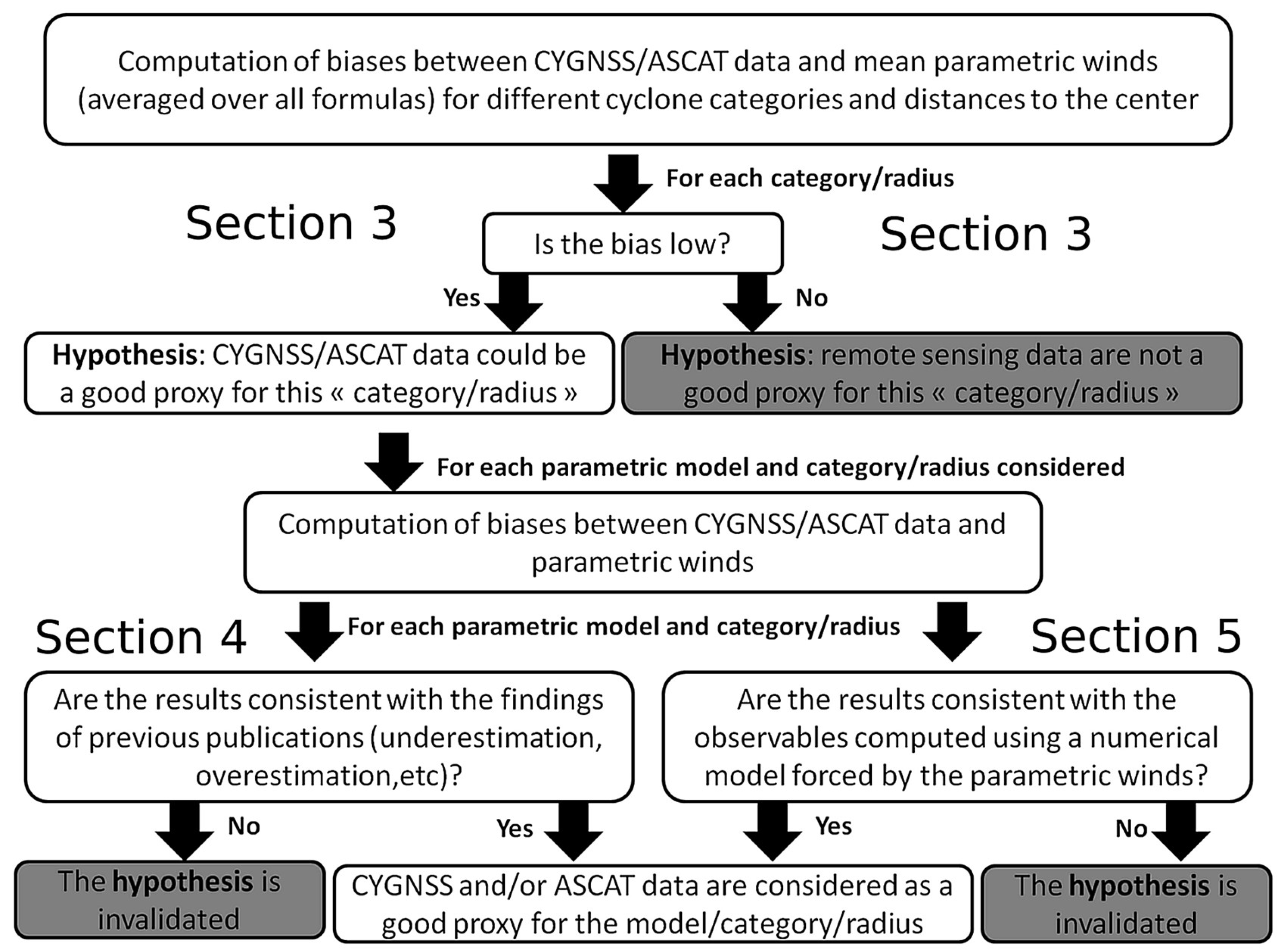
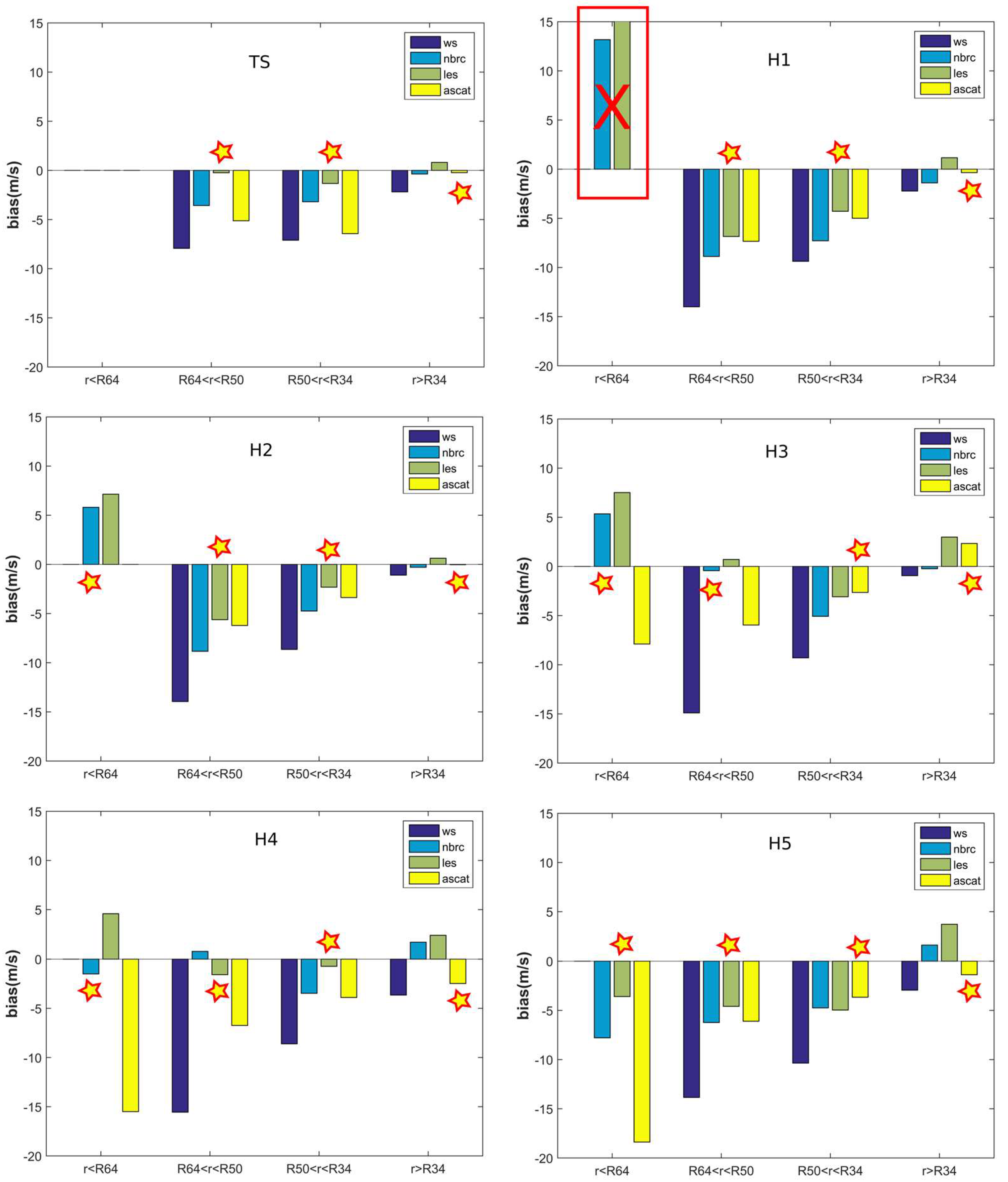
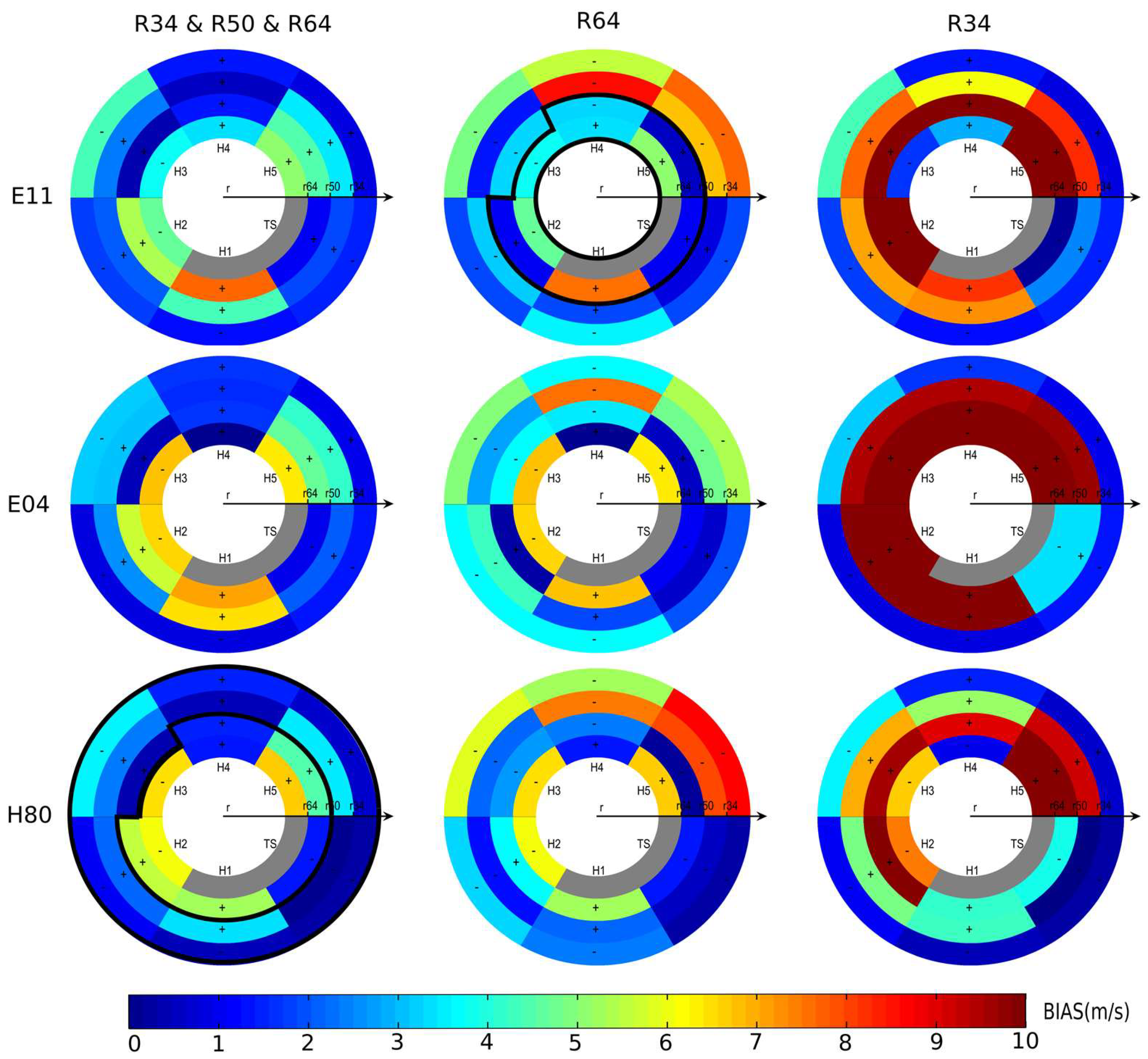
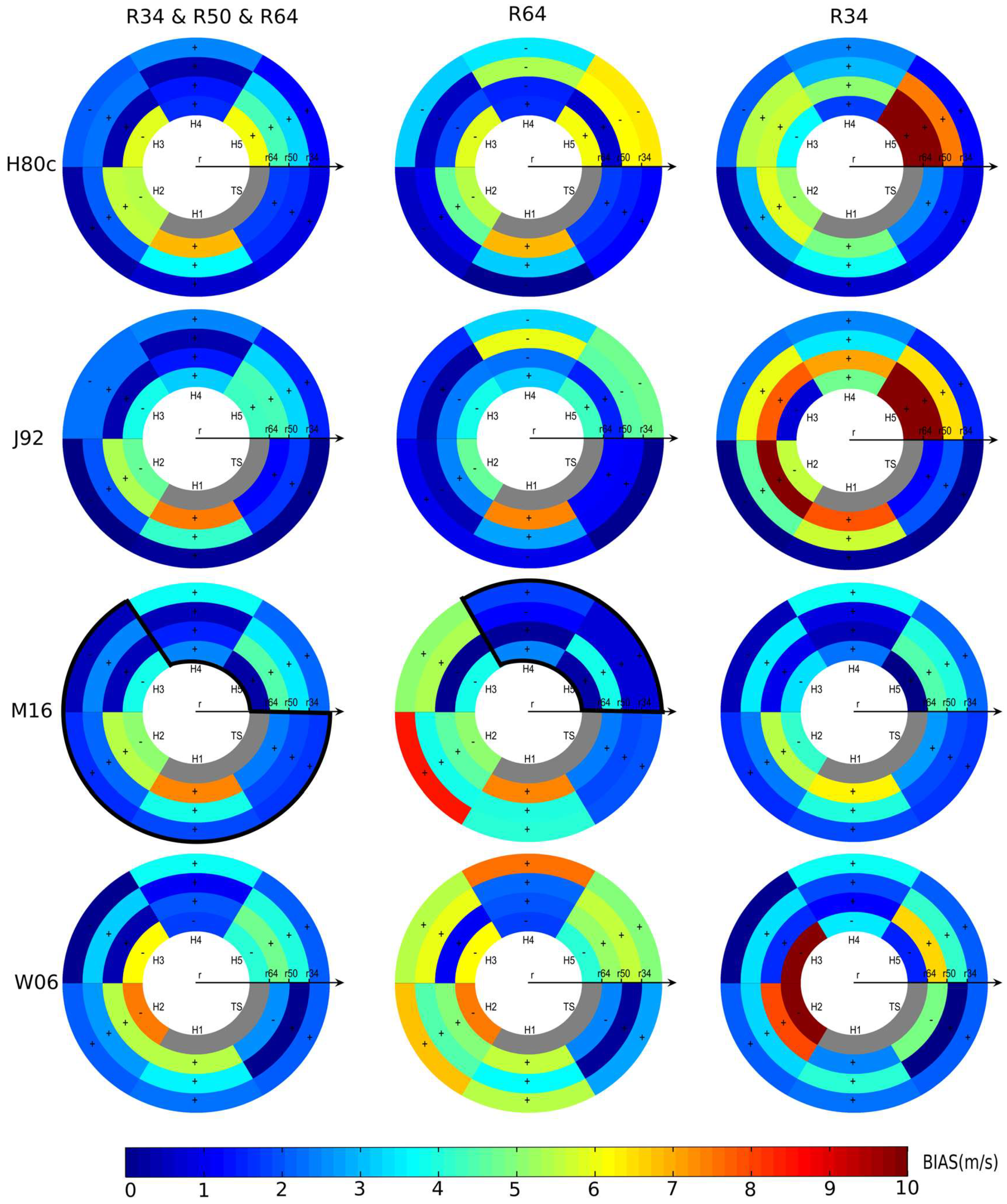
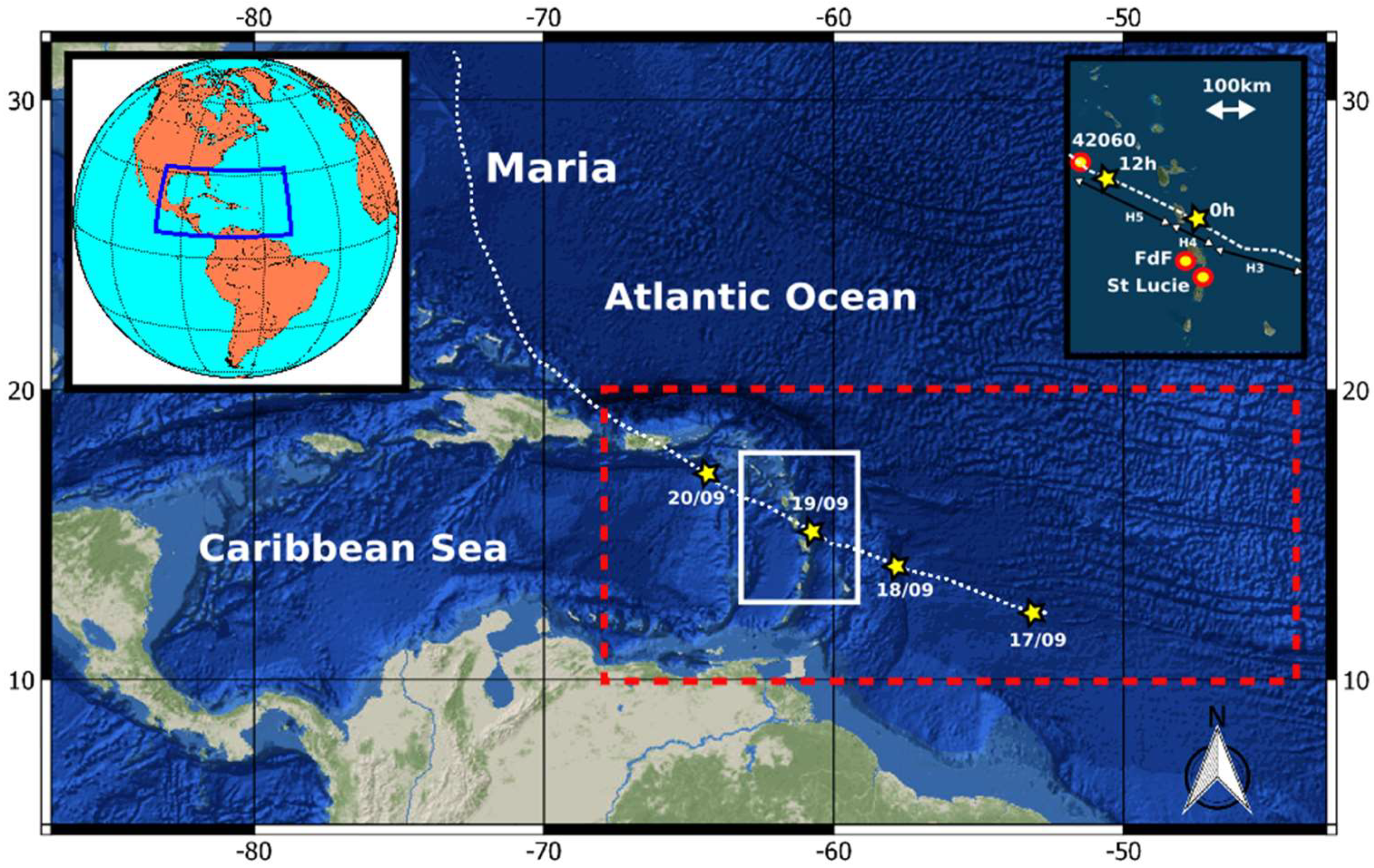
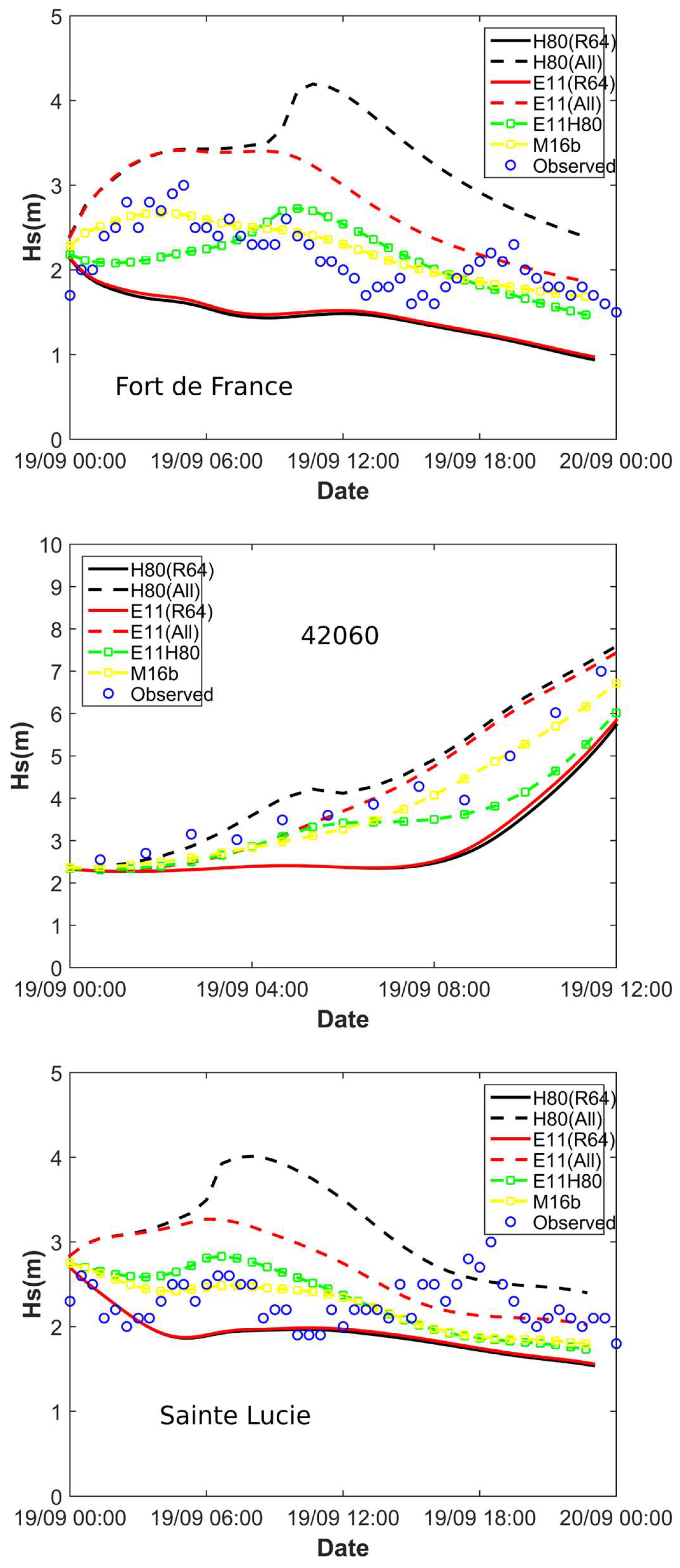
| Number | Name | Basin | Dates (Year 2017) | TCCategory (Max WS) | Min/Max R34 | Min/Max R50 | Min/Max R64 |
|---|---|---|---|---|---|---|---|
| 1 | Dora | EP | 25/06 → 28/06 | 1 (80 kt) | 40/70 | 20/40 | 15/25 |
| 2 | Eugene | EP | 07/07 → 10/07 | 3 (100 kt) | 60/110 | 40/80 | 20/30 |
| 3 | Franklin | ATL | 07/08 → 10/08 | 1 (75 kt) | 60/130 | 30/50 | NA/30 |
| 4 | Gert | ATL | 13/08 → 17/08 | 2 (90 kt) | 50/120 | 15/60 | NA/30 |
| 5 | Harvey | ATL | 17/08 → 30/08 | 4 (115 kt) | 70/120 | 40/60 | 20/35 |
| 6 | Hilary | EP | 24/08 → 30/08 | 2 (90 kt) | 60/90 | 30/50 | 15/20 |
| 7 | Irma | ATL | 30/08 → 11/09 | 5 (160 kt) | 80/160 | 50/100 | 30/45 |
| 8 | Irwin | EP | 23/07 → 01/08 | 1 (80 kt) | 30/60 | 10/30 | NA/15 |
| 9 | Jose | ATL | 05/09 → 22/09 | 4 (135 kt) | 50/120 | 30/50 | 20/30 |
| 10 | Katia | ATL | 06/09 → 09/09 | 2 (90 kt) | 60/60 | 20/40 | 15/20 |
| 11 | Kenneth | EP | 19/08 → 23/08 | 4 (115 kt) | 60/90 | 30/50 | 15/25 |
| 12 | Lee | ATL | 16/09 → 30/09 | 3 (100 kt) | 60/80 | 40/50 | 25/30 |
| 13 | Maria | ATL | 16/09 → 30/09 | 5 (150 kt) | 100/150 | 60/80 | 35/50 |
| 14 | Max | EP | 13/09 → 15/09 | 1 (70 kt) | 30/40 | 20/20 | 10/10 |
| 15 | Norma | EP | 14/09 → 19/09 | 1 (65 kt) | 70/80 | 30/50 | NA/25 |
| 16 | Otis | EP | 16/09 → 19/09 | 3 (100 kt) | 40/60 | 20/40 | 10/20 |
| Name | Main Reference | Formula |
|---|---|---|
| E11 | Emanuel and Rotunno [36] | |
| E04 | Emanuel [46] | with b = 0.25, m = 1.6, n = 0.9, R0 = 420 km |
| J92 | Jelesnianski et al. [47] | |
| H80 | Holland [33] | with , , |
| H80c | Holland [33] with cyclostrophic approximation | with , , |
| M16 | Murty et al. [37] | with |
| W06 | Willoughby et al. [38] | For : with For : with |
| Fort de France | St Lucie | 42060 | ||
|---|---|---|---|---|
| H80 (R64) | Bias | −0.74 m | −0.40 m | −1.18 m |
| RMS | 0.81 m | 0.52 m | 1.29 m | |
| NRMS | 37% | 23% | 30% | |
| H80 (All) | Bias | 1.11 m | 0.83 m | 0.44 m |
| RMS | 1.24 m | 1.03 m | 0.64 m | |
| NRMS | 57% | 45% | 15% | |
| E11 (R64) | Bias | −0.71 m | −0.38 m | −1.14 m |
| RMS | 0.77 m | 0.50 m | 1.23 m | |
| NRMS | 36% | 22% | 28% | |
| E11 (All) | Bias | 0.62 m | 0.38 m | 0.13 m |
| RMS | 0.72 m | 0.65 m | 0.56 m | |
| NRMS | 33% | 29% | 13% | |
| E11H80 | Bias | −0.04 m | 0.02 m | −0.64 m |
| RMS | 0.41 m | 0.46 m | 0.75 m | |
| NRMS | 19% | 20% | 17% | |
| M16b | Bias | 0.06 m | −0.06 m | −0.28 m |
| RMS | 0.25 m | 0.40 m | 0.40 m | |
| NRMS | 11.5% | 17.4% | 9.1% | |
© 2018 by the authors. Licensee MDPI, Basel, Switzerland. This article is an open access article distributed under the terms and conditions of the Creative Commons Attribution (CC BY) license (http://creativecommons.org/licenses/by/4.0/).
Share and Cite
Krien, Y.; Arnaud, G.; Cécé, R.; Ruf, C.; Belmadani, A.; Khan, J.; Bernard, D.; Islam, A.K.M.S.; Durand, F.; Testut, L.; et al. Can We Improve Parametric Cyclonic Wind Fields Using Recent Satellite Remote Sensing Data? Remote Sens. 2018, 10, 1963. https://doi.org/10.3390/rs10121963
Krien Y, Arnaud G, Cécé R, Ruf C, Belmadani A, Khan J, Bernard D, Islam AKMS, Durand F, Testut L, et al. Can We Improve Parametric Cyclonic Wind Fields Using Recent Satellite Remote Sensing Data? Remote Sensing. 2018; 10(12):1963. https://doi.org/10.3390/rs10121963
Chicago/Turabian StyleKrien, Yann, Gaël Arnaud, Raphaël Cécé, Chris Ruf, Ali Belmadani, Jamal Khan, Didier Bernard, A.K.M.S. Islam, Fabien Durand, Laurent Testut, and et al. 2018. "Can We Improve Parametric Cyclonic Wind Fields Using Recent Satellite Remote Sensing Data?" Remote Sensing 10, no. 12: 1963. https://doi.org/10.3390/rs10121963
APA StyleKrien, Y., Arnaud, G., Cécé, R., Ruf, C., Belmadani, A., Khan, J., Bernard, D., Islam, A. K. M. S., Durand, F., Testut, L., Palany, P., & Zahibo, N. (2018). Can We Improve Parametric Cyclonic Wind Fields Using Recent Satellite Remote Sensing Data? Remote Sensing, 10(12), 1963. https://doi.org/10.3390/rs10121963





